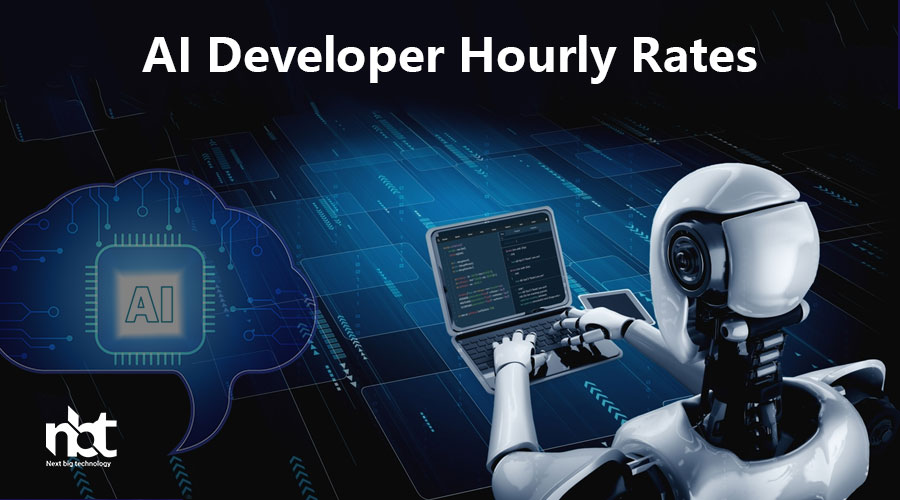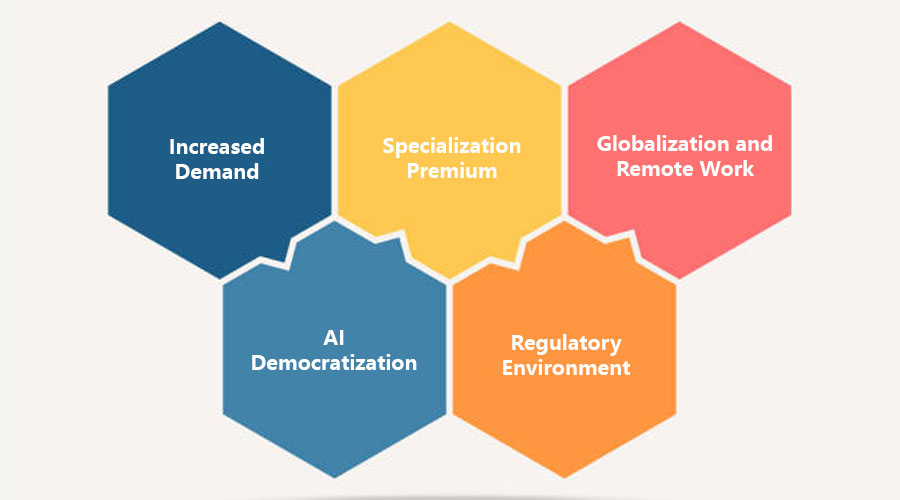Table of Contents
Understanding AI Developer Hourly Rates
In today’s rapidly evolving digital landscape, the demand for artificial intelligence (AI) developers is skyrocketing. With AI becoming the cornerstone of innovation across various industries, understanding the nuances of AI developer hourly rates is crucial for businesses and aspiring developers alike. In this article, we’ll delve into the factors influencing AI developer rates, providing you with valuable insights to navigate this dynamic field.
- Skillset and Expertise: AI developers possess a diverse skill set encompassing machine learning, natural language processing, deep learning, and more. The depth of their expertise significantly impacts their hourly rates. Developers with advanced degrees, extensive experience, and a proven track record command higher rates due to their specialized knowledge and ability to tackle complex AI projects.
- Project Complexity: The complexity of the AI project plays a pivotal role in determining developer rates. Projects requiring sophisticated algorithms, intricate data analysis, and custom AI solutions inherently demand higher hourly rates. Developers need to invest substantial time and effort in understanding project requirements, designing algorithms, and fine-tuning models, which influences their pricing structure.
- Industry Demands: The demand-supply dynamics within specific industries influence AI developer rates. Industries such as finance, healthcare, and e-commerce, which heavily rely on AI-driven solutions, often experience higher competition for top-tier developers, leading to inflated hourly rates. Conversely, industries with relatively lower AI adoption may offer developers lower rates due to less demand.
- Location: Geographical location is a significant determinant of AI developer rates. Developers based in tech hubs like Silicon Valley, New York City, or London typically command higher rates compared to their counterparts in less affluent regions. The cost of living, market demand, and prevailing economic conditions in a particular location directly impact the rates developers charge for their services.
- Type of Engagement: The nature of the engagement, whether it’s a short-term project, long-term contract, or freelance assignment, influences AI developer rates. Freelancers and consultants often charge higher hourly rates to compensate for the lack of job security and benefits associated with full-time employment. Conversely, developers employed by tech giants or established companies may receive lower hourly rates but benefit from stability and additional perks.
- Specialized Tools and Platforms: AI developers leverage a myriad of tools, libraries, and platforms to develop and deploy AI solutions efficiently. The utilization of specialized tools and platforms, which may entail licensing fees or additional costs, can impact developer rates. Developers proficient in cutting-edge AI frameworks or proprietary technologies may command higher rates due to their expertise and access to premium resources.
- Market Trends and Demand-Supply Dynamics: The ever-evolving nature of the AI industry and shifting market trends directly influence developer rates. Factors such as emerging technologies, regulatory changes, and industry disruptions can create fluctuations in demand for AI talent, subsequently affecting hourly rates. Staying abreast of market trends and demand-supply dynamics enables businesses to make informed decisions when hiring AI developers.
Factors Influencing AI Developer Rates
In the ever-evolving landscape of technology, artificial intelligence (AI) stands out as a transformative force, revolutionizing industries and reshaping the way we perceive and interact with the digital world. Behind the scenes of this AI revolution are the skilled developers who breathe life into algorithms, models, and applications. However, the rates for AI developers vary significantly, influenced by a myriad of factors. Let’s delve into the key determinants shaping the rates of AI developers in today’s market.
- Expertise and Experience: The proficiency and experience level of an AI developer play a pivotal role in determining their rates. Developers with a proven track record of successful AI projects, advanced degrees, or specialized certifications often command higher fees due to their expertise and ability to deliver high-quality solutions.
- Complexity of Projects: The complexity and scope of AI projects greatly impact developer rates. Projects requiring advanced algorithms, extensive data processing, or integration with complex systems typically command higher rates due to the specialized skills and time commitment involved in their development.
- Technology Stack: The choice of technology stack also influences AI developer rates. Developers skilled in popular AI frameworks such as TensorFlow, PyTorch, or scikit-learn may charge higher rates, reflecting the demand for expertise in specific tools and technologies within the AI ecosystem.
- Market Demand: Like any other profession, AI developer rates are subject to market demand and supply dynamics. In regions or industries experiencing high demand for AI talent but limited supply, developers can demand higher rates due to their scarcity. Conversely, in saturated markets or industries with abundant AI talent, rates may be more competitive.
- Location: Geographical location plays a significant role in determining AI developer rates. Developers based in tech hubs such as Silicon Valley, New York City, or London often command higher rates due to the higher cost of living and increased demand for talent in these areas. On the other hand, developers in regions with lower living costs may offer more competitive rates.
- Project Duration and Timeline: The duration and timeline of AI projects impact developer rates, with longer or more time-sensitive projects often commanding higher fees. Developers may factor in opportunity costs and the commitment required to meet project deadlines when determining their rates.
- Client Reputation and Project Visibility: The reputation of the client and the visibility of the project can influence developer rates. Developers may be willing to negotiate lower rates for high-profile clients or projects that offer valuable exposure and networking opportunities, enhancing their professional portfolio and future prospects.
- Additional Services and Support: Developers offering additional services such as ongoing maintenance, support, or consultation may charge higher rates to reflect the added value they bring to the table beyond initial development.
Skillset and Specializations Impacting Hourly Rates
In today’s competitive job market, understanding the factors that impact hourly rates is crucial for both freelancers and employers alike. Among these factors, skillset and specializations play a significant role in determining the value of a professional’s time. Whether you’re a seasoned freelancer or a business owner looking to hire talent, grasping the relationship between skillsets, specializations, and hourly rates is key to making informed decisions.
The Power of Skillset:
Skillset refers to the collection of abilities, expertise, and knowledge that an individual possesses within a particular field. The more specialized and in-demand the skills, the higher the hourly rate tends to be. For instance, a software developer proficient in niche programming languages like Python or Ruby on Rails may command a higher hourly rate compared to someone with basic coding skills.
Moreover, the depth of experience and level of proficiency in a skill can also impact rates. A developer with years of experience and a proven track record of delivering high-quality projects is likely to charge more per hour than a novice in the field.
Specializations:
Specializations narrow down skillsets into specific areas within a field. For example, within the realm of marketing, a digital marketer may specialize in search engine optimization (SEO), social media marketing, or content marketing. Similarly, within the realm of healthcare, a nurse may specialize in pediatric care, oncology, or critical care.
Specializations not only demonstrate expertise in a particular niche but also indicate a deeper understanding of industry trends, best practices, and emerging technologies. Consequently, professionals with specialized knowledge often command higher hourly rates due to the perceived value they bring to projects.
Factors Influencing Hourly Rates:
- Demand and Supply: The demand for specific skills and specializations in the market directly influences hourly rates. If there’s a scarcity of professionals with certain expertise, their rates are likely to be higher due to increased demand.
- Industry Standards: Different industries have varying norms and standards regarding hourly rates for specific skillsets and specializations. Understanding industry benchmarks can help both freelancers and employers set fair and competitive rates.
- Geographical Location: Hourly rates can also vary significantly based on geographical location. Professionals working in major metropolitan areas or regions with a high cost of living typically charge higher rates compared to those in smaller cities or rural areas.
- Experience and Reputation: Seasoned professionals with a proven track record of success and a strong reputation within their industry often command premium rates for their services.
- Project Complexity: The complexity and scope of a project can influence hourly rates. Projects requiring specialized knowledge, extensive research, or tight deadlines may warrant higher rates to compensate for the additional effort and expertise required.
Finding the Right Balance: For freelancers, it’s essential to assess their skillset, level of expertise, and market demand to determine an appropriate hourly rate that reflects their value. Conducting research on industry standards and staying updated on market trends can help freelancers stay competitive while ensuring they’re adequately compensated for their services.
For employers, understanding the correlation between skillsets, specializations, and hourly rates is crucial for budgeting and hiring decisions. While cost-effectiveness is important, it’s equally essential to recognize the value that skilled professionals bring to a project and be willing to invest accordingly.
Industry Demands and Trends in AI Developer Rates
In today’s digitally-driven world, the demand for AI developers is skyrocketing as businesses across various industries recognize the transformative potential of artificial intelligence. As companies strive to leverage AI technologies to gain a competitive edge, understanding the prevailing trends in AI developer rates becomes crucial for both employers and professionals in the field.
The landscape of AI development is dynamic, influenced by factors such as technological advancements, market demands, and the availability of skilled talent. Let’s delve into some key industry demands and trends shaping AI developer rates:
- Rising Demand for Specialized Skills: As AI applications become more diverse and sophisticated, there’s a growing need for developers with specialized skills in areas such as machine learning, natural language processing, computer vision, and deep learning. Developers who possess expertise in niche domains command higher rates due to their ability to tackle complex challenges and deliver innovative solutions.
- Supply-Demand Imbalance: The demand for AI talent far exceeds the current supply, leading to a competitive market where skilled developers can negotiate premium rates. Companies are willing to offer lucrative compensation packages to attract top-tier talent, leading to an upward trend in AI developer rates.
- Industry-specific Expertise: Different industries have varying requirements when it comes to AI implementation. For instance, healthcare organizations may seek developers with knowledge of medical data analysis and compliance standards, while fintech companies prioritize professionals with experience in fraud detection and algorithmic trading. Developers who possess industry-specific expertise often command higher rates due to their ability to understand and address sector-specific challenges.
- Geographical Disparities: AI developer rates vary significantly across different geographical regions. Tech hubs such as Silicon Valley, New York City, and London typically have higher rates due to the concentration of tech companies and the cost of living. Conversely, emerging tech markets in regions like Eastern Europe, India, and Southeast Asia offer more competitive rates while still maintaining high-quality talent pools.
- Freelance vs. In-house Developers: The rise of remote work and the gig economy has reshaped the way companies source AI talent. While in-house developers may demand higher rates due to benefits and job security, freelance developers offer flexibility and cost-effectiveness. The choice between hiring freelance or in-house developers depends on factors such as project scope, budget, and long-term strategic goals.
- Impact of Emerging Technologies: Advancements in AI, such as automated machine learning (AutoML), pre-trained models, and AIaaS (AI as a Service), are democratizing AI development and driving efficiencies. These technologies have the potential to lower the barrier to entry for businesses, thereby influencing AI developer rates as demand shifts towards higher-value tasks such as model customization, optimization, and integration.
- Focus on Ethical AI: With increased scrutiny on AI ethics and responsible AI development, developers with expertise in ethical AI frameworks, bias mitigation techniques, and regulatory compliance are in high demand. Companies are willing to invest in developers who prioritize ethical considerations in AI projects, leading to an uptick in rates for professionals with this skill set.
Experience Levels and Their Influence on Rates
In the dynamic landscape of today’s job market, the correlation between experience levels and rates is a crucial factor influencing both employers and employees. Whether you’re a seasoned professional or just starting out in your career, understanding how experience levels affect rates can help you navigate negotiations and make informed decisions. Let’s delve into this intricate relationship across different industries.
- Entry-Level Positions: Entry-level roles typically attract candidates with minimal to no prior experience in a particular field. Consequently, rates for these positions tend to be lower compared to more advanced roles. However, entry-level positions serve as stepping stones for individuals to gain valuable experience and build a foundation for their careers. While the rates may be modest initially, the opportunity to learn and grow often outweighs the immediate financial compensation.
- Mid-Level Positions: As professionals gain expertise and proficiency in their respective fields, they progress to mid-level positions. Rates for mid-level roles reflect a balance between experience and responsibility. Individuals in these positions are expected to possess a certain level of competency and are often compensated accordingly. However, rates can vary significantly based on factors such as industry demand, geographic location, and specific skill sets.
- Senior-Level Positions: Senior-level roles require extensive experience, specialized skills, and a proven track record of success. Consequently, rates for senior-level positions are typically higher to attract and retain top talent. Professionals at this level are often entrusted with leadership responsibilities and are expected to drive strategic initiatives within their organizations. Negotiating rates for senior-level positions may involve comprehensive discussions on performance metrics, project scope, and long-term objectives.
- Consulting and Freelancing: In fields such as consulting and freelancing, rates are largely influenced by an individual’s expertise and reputation. Consultants and freelancers often command higher rates based on their years of experience, industry knowledge, and past accomplishments. Clients are willing to pay premium rates for specialized services and insights that deliver tangible results. Building a strong portfolio and establishing a credible reputation are essential for consultants and freelancers to justify their rates and secure lucrative projects.
- Creative Industries: In creative industries such as design, writing, and photography, rates can vary widely based on factors such as skill level, portfolio quality, and market demand. Experienced creatives with a strong portfolio and established client base can command higher rates for their services. However, emerging talents may need to initially accept lower rates to gain exposure and build their portfolio. Networking, showcasing unique talents, and delivering exceptional results are essential strategies for creatives to increase their rates over time.
- Tech and IT Sector: In the fast-paced tech and IT sector, rates for professionals are influenced by factors such as programming languages, certifications, and project complexity. Experienced software developers, data scientists, and IT consultants often earn premium rates due to high demand and specialized skills. Continuous learning and staying updated with the latest technologies are essential for professionals in the tech sector to maintain competitive rates and remain sought after in the industry.
Freelance vs. Agency: Variances in Hourly Rates
In the ever-evolving landscape of modern work, the choice between freelancing and working with an agency has become a significant decision for many professionals. Among the myriad of factors to consider, one crucial aspect is the variance in hourly rates between freelancers and agencies. Understanding these differences can help individuals make informed decisions about their career paths or when seeking services for their projects.
Freelancers, as independent contractors, often set their hourly rates based on various factors such as their expertise, experience, demand for their services, and the specific nature of the project. Since freelancers operate on their own, they have the autonomy to adjust their rates accordingly. This flexibility can result in a wide range of hourly rates within the freelance market. For instance, a freelance web designer may charge anywhere from $25 to $150 per hour, depending on their skill level and the complexity of the project.
On the other hand, agencies typically have a structured pricing model that takes into account overhead costs, employee salaries, administrative expenses, and profit margins. As a result, agency hourly rates tend to be higher compared to individual freelancers. However, clients often perceive agency services as more reliable and comprehensive due to the collective expertise and resources available within an agency team. For example, a digital marketing agency may charge anywhere from $75 to $300 per hour for their services.
When deciding between hiring a freelancer or working with an agency, it’s essential to consider the specific requirements and goals of your project. Freelancers may be more suitable for smaller-scale projects or those that require specialized expertise. They offer personalized attention, flexibility, and often a more cost-effective solution. On the other hand, agencies are better equipped to handle larger and more complex projects that demand a comprehensive range of services. They provide a team-based approach, streamlined processes, and a higher level of accountability.
Furthermore, it’s crucial to evaluate the value proposition of each option. While freelancers may offer lower hourly rates, agencies may provide additional benefits such as access to a diverse talent pool, established workflows, quality assurance processes, and ongoing support. Consider factors such as project timeline, budget constraints, desired level of collaboration, and the importance of scalability when making your decision.
Ultimately, there is no one-size-fits-all answer when it comes to choosing between freelancers and agencies. Both options have their advantages and drawbacks, and the decision should be based on your specific needs and preferences. Whether you opt for the flexibility of freelancing or the comprehensive services of an agency, what matters most is finding the right fit for your project and achieving your desired outcomes.
Emerging Technologies and their Impact on Rates
In today’s fast-paced world, emerging technologies are revolutionizing every aspect of our lives, including how we conduct business and manage finances. From artificial intelligence (AI) to blockchain and the Internet of Things (IoT), these innovations are reshaping industries and influencing economic landscapes. One area where their impact is particularly significant is in the realm of rates, affecting everything from interest rates to insurance premiums. Let’s delve into how emerging technologies are shaping this landscape and what it means for businesses and consumers alike.
- Artificial Intelligence (AI): AI has emerged as a game-changer in various sectors, and its influence on rates is profound. AI-powered algorithms can analyze vast amounts of data with unprecedented speed and accuracy, enabling financial institutions to make more informed decisions about setting rates. For example, AI algorithms can assess risk factors more comprehensively, leading to more personalized and dynamic pricing models for insurance premiums and loan interest rates. This increased precision benefits both businesses, which can optimize their pricing strategies, and consumers, who may enjoy fairer rates tailored to their individual circumstances.
- Blockchain Technology: Blockchain technology, best known as the backbone of cryptocurrencies like Bitcoin, is disrupting traditional financial systems by offering transparency, security, and efficiency. In the realm of rates, blockchain’s decentralized nature has the potential to streamline transactions and reduce costs associated with intermediaries. For instance, in the mortgage industry, blockchain-based smart contracts could automate and expedite the loan approval process, potentially leading to lower mortgage rates for borrowers. Moreover, the immutable nature of blockchain records enhances trust and mitigates fraud, further influencing rate-setting mechanisms across various financial products and services.
- Internet of Things (IoT): The Internet of Things, characterized by interconnected devices sharing data over the internet, is creating new opportunities for risk assessment and pricing strategies. In the insurance sector, IoT-enabled devices such as telematics in vehicles or smart home sensors provide real-time data on behavior and usage patterns. Insurers can leverage this data to offer usage-based insurance policies, where premiums are determined by actual usage rather than general risk profiles. As a result, safer drivers or homeowners adopting preventive measures may enjoy lower rates, incentivizing responsible behavior and reducing overall risk for insurers.
- Robotic Process Automation (RPA): Robotic Process Automation involves the use of software robots to automate repetitive tasks and streamline workflows. In the financial sector, RPA is revolutionizing back-office operations, leading to cost savings and increased efficiency. When it comes to rate-setting, RPA can accelerate data processing, allowing financial institutions to respond rapidly to market changes and adjust rates accordingly. Additionally, by minimizing manual errors and ensuring compliance with regulations, RPA contributes to more accurate rate calculations and reduces the likelihood of pricing discrepancies.
- Quantum Computing: Although still in its nascent stages, quantum computing holds immense potential to revolutionize the financial industry, including rate-setting processes. Quantum computers can perform complex calculations at speeds unattainable by classical computers, enabling more sophisticated risk assessments and pricing models. For example, quantum algorithms could optimize portfolios in real-time, leading to more efficient asset pricing and risk management strategies. While widespread adoption of quantum computing in finance may still be years away, its eventual impact on rate-setting mechanisms could be transformative.
Ethical Considerations in AI Development Rates
In the rapidly advancing landscape of artificial intelligence (AI), the development rates are nothing short of astounding. However, amidst the fervor for innovation and progress, it’s imperative to pause and consider the ethical implications inherent in AI development. As we delve deeper into the realms of machine learning, algorithmic decision-making, and autonomous systems, ethical considerations become increasingly crucial.
Ethical considerations in AI development encompass a broad spectrum of issues, ranging from privacy concerns and bias in algorithms to the societal impacts of AI-driven automation. One of the primary ethical dilemmas revolves around the responsible use of data. AI systems heavily rely on vast amounts of data for training and decision-making. However, the collection and utilization of personal data raise significant privacy concerns. Developers must prioritize data privacy and ensure transparency regarding how data is collected, stored, and utilized.
Another critical aspect is the potential for bias in AI algorithms. AI systems are only as unbiased as the data they are trained on. If the training data is skewed or reflects societal biases, it can perpetuate and even exacerbate existing inequalities. To address this challenge, developers must employ techniques such as data preprocessing, diverse dataset collection, and ongoing algorithmic audits to mitigate bias and ensure fairness in AI applications.
Moreover, the deployment of AI technologies raises profound ethical questions regarding accountability and decision-making. Autonomous systems capable of making decisions independently pose unique challenges in assigning responsibility in the event of errors or harm. Establishing clear lines of accountability and implementing mechanisms for human oversight are essential safeguards to prevent the misuse or abuse of AI systems.
Furthermore, as AI-driven automation reshapes industries and labor markets, ethical considerations extend to the societal impacts of job displacement and economic inequality. Developers must proactively engage with stakeholders to anticipate and address these consequences, whether through retraining programs, universal basic income initiatives, or other forms of social support.
In navigating these ethical considerations, collaboration and interdisciplinary dialogue are paramount. Ethical AI development requires the input and expertise of not only computer scientists and engineers but also ethicists, policymakers, social scientists, and representatives from diverse communities. By fostering a culture of ethical reflection and accountability, we can ensure that AI technologies serve the collective good while respecting fundamental human values.
Ultimately, ethical considerations should not be viewed as obstacles to AI development but rather as guiding principles that enhance innovation and foster trust. By prioritizing transparency, fairness, accountability, and societal well-being, we can harness the transformative potential of AI in a responsible and sustainable manner. As we continue to push the boundaries of AI technology, let us remain vigilant in upholding ethical standards that uphold human dignity and promote the common good.
Future Projections of AI Developer Hourly Rates
In the ever-evolving landscape of technology, Artificial Intelligence (AI) stands at the forefront, reshaping industries and revolutionizing the way we live and work. Behind every groundbreaking AI innovation lies the expertise of AI developers, the architects of tomorrow’s digital world. As the demand for AI solutions continues to surge, the trajectory of AI developer hourly rates becomes an intriguing subject, reflecting the evolving dynamics of supply, demand, and technological advancements.
Current Trends and Factors Influencing AI Developer Rates
Before delving into future projections, it’s essential to understand the current landscape. The hourly rates of AI developers vary significantly based on several factors:
- Experience and Expertise: Seasoned AI developers with a proven track record command higher rates compared to novices. Years of experience, specialized skills, and a portfolio of successful projects contribute to their market value.
- Location: Geographical location plays a crucial role in determining AI developer rates. Developers based in tech hubs such as Silicon Valley or New York City generally demand higher compensation due to the high cost of living and intense competition.
- Industry Demand: Industries like finance, healthcare, e-commerce, and autonomous vehicles have a voracious appetite for AI solutions. Consequently, developers specializing in these domains often enjoy premium rates.
- Technological Advancements: The rapid evolution of AI tools, frameworks, and libraries influences developer rates. Proficiency in cutting-edge technologies like machine learning, deep learning, natural language processing, and computer vision commands higher premiums.
Future Projections: What Lies Ahead?
As we peer into the future, several trends and developments offer insights into the trajectory of AI developer hourly rates:
- Increased Demand: The demand for AI solutions is poised to escalate across industries as organizations embrace automation, predictive analytics, and personalized customer experiences. This surge in demand will exert upward pressure on AI developer rates.
- Specialization Premium: As AI technologies become more sophisticated and diverse, developers with specialized expertise in niche areas such as reinforcement learning, generative adversarial networks (GANs), and AI ethics will command premium rates due to their scarcity and high demand.
- Globalization and Remote Work: The proliferation of remote work fueled by advancements in communication technology will enable companies to access talent pools beyond their geographical confines. This globalization of talent will lead to more competitive pricing for AI development services, potentially exerting downward pressure on rates.
- AI Democratization: The democratization of AI tools and platforms will empower non-specialists to develop AI solutions, reducing reliance on highly skilled developers for routine tasks. While this may create some downward pressure on rates for basic AI development, demand for expert developers for complex projects will remain robust.
- Regulatory Environment: The evolving regulatory landscape surrounding AI, particularly in areas like data privacy, algorithmic transparency, and bias mitigation, will necessitate specialized expertise and compliance measures. Developers well-versed in regulatory requirements will be in high demand, commanding premium rates for their services.
Navigating the Future: Strategies for AI Developers and Employers
For AI developers, staying abreast of emerging technologies, honing specialized skills, and building a strong professional network will be critical for maintaining competitive rates in the evolving market. Embracing lifelong learning and adapting to industry trends will ensure relevance and demand in the marketplace.
Employers seeking AI development services should prioritize collaboration with reputable firms or freelancers with a proven track record of delivering high-quality solutions. Investing in talent development, fostering a culture of innovation, and offering competitive compensation packages will be instrumental in attracting and retaining top-tier AI developers.
Top AI Developer Hourly Rates Companies
In the fast-evolving landscape of artificial intelligence (AI), finding the right talent can be the key differentiator between success and stagnation for companies. With AI permeating nearly every industry, the demand for skilled AI developers is skyrocketing. However, navigating the terrain of hourly rates and selecting the right company for your AI project can be daunting. Fear not! This guide is here to shed light on the top AI developer hourly rate companies, helping you make informed decisions and propel your AI initiatives forward.
-
Next Big Technology:

Focus Area
- Mobile App Development
- App Designing (UI/UX)
- Software Development
- Web Development
- AR & VR Development
- Big Data & BI
- Cloud Computing Services
- DevOps
- E-commerce Development
Industries Focus
- Art, Entertainment & Music
- Business Services
- Consumer Products
- Designing
- Education
- Financial & Payments
- Gaming
- Government
- Healthcare & Medical
- Hospitality
- Information Technology
- Legal & Compliance
- Manufacturing
- Media
2. IBM Watson AI Developers: IBM Watson, the epitome of cognitive computing, houses some of the brightest minds in the AI realm. Leveraging cutting-edge technologies such as natural language processing and computer vision, IBM Watson AI developers deliver solutions tailored to diverse business needs. While IBM’s hourly rates may lean towards the higher end, the investment often translates into transformative AI solutions with tangible business outcomes.
3. Amazon AI Developers: Amazon Web Services (AWS), with its robust suite of AI services, is a go-to destination for companies embarking on AI-driven ventures. Whether it’s building conversational interfaces with Amazon Lex or harnessing the power of deep learning with Amazon SageMaker, AWS offers a diverse talent pool of AI developers at competitive hourly rates. With flexible pricing models and scalable solutions, Amazon caters to startups and enterprises alike, making AI adoption accessible to all.
4. Microsoft Azure AI Developers: Microsoft Azure stands out as a prominent player in the AI arena, empowering businesses with AI-driven insights and innovations. Azure’s AI developers bring a wealth of expertise in areas like predictive analytics, image recognition, and speech recognition. With transparent pricing structures and customizable solutions, Microsoft Azure offers competitive hourly rates, making AI development feasible for businesses of all sizes.
5. Nvidia AI Developers: Nvidia, renowned for its prowess in GPU-accelerated computing, is a hub for AI developers pushing the boundaries of what’s possible. From training complex neural networks to deploying AI-powered applications, Nvidia’s developers possess the technical acumen to tackle even the most daunting AI challenges. While Nvidia’s hourly rates may reflect the premium quality of service, the investment yields unparalleled performance and efficiency in AI development.
FAQs On AI Developer Hourly Rates
In the rapidly evolving landscape of technology, artificial intelligence (AI) has emerged as a game-changer across various industries. From enhancing customer experiences to automating processes, businesses are increasingly turning to AI solutions to stay competitive. However, one question that often arises is: What are the hourly rates for AI developers? In this article, we aim to address this question and provide clarity through a detailed FAQ guide.
What factors influence AI developer hourly rates?
Several factors influence the hourly rates charged by AI developers:
- Experience and Expertise: Developers with extensive experience and specialized expertise in AI technologies often command higher hourly rates.
- Complexity of the Project: Projects requiring advanced AI algorithms, machine learning models, or deep learning architectures may incur higher costs due to their complexity.
- Location: Hourly rates vary significantly based on the developer’s geographical location. Developers in regions with a high cost of living, such as Silicon Valley, typically charge more than those in other areas.
- Industry Demand: Industries with high demand for AI solutions, such as finance, healthcare, and e-commerce, may experience higher hourly rates due to increased competition for skilled developers.
- Scope of Work: The scope and scale of the project, including the number of features, functionalities, and customization requirements, can impact hourly rates.
What is the average hourly rate for AI developers?
The average hourly rate for AI developers varies widely depending on the factors mentioned above. However, as a general guideline:
- Entry-level AI developers: $50 to $100 per hour
- Mid-level AI developers: $100 to $150 per hour
- Senior AI developers: $150 to $300+ per hour
How can I find the right AI developer within my budget?
Finding the right AI developer within your budget requires thorough research and consideration of the following steps:
- Define Your Project Requirements: Clearly define your project goals, scope, and budget constraints to communicate effectively with potential developers.
- Research and Compare Rates: Research AI developers online, review their portfolios, and compare hourly rates to find developers whose rates align with your budget.
- Evaluate Experience and Expertise: Look for developers with relevant experience and expertise in AI technologies relevant to your project requirements.
- Consider Freelancers vs. Agencies: Evaluate the pros and cons of hiring freelancers versus AI development agencies based on your project’s complexity, timeline, and budget.
- Negotiate Terms: Negotiate hourly rates, project timelines, and deliverables with selected developers to ensure they fit within your budget constraints.
Are there any additional costs associated with hiring AI developers?
In addition to hourly rates, there may be additional costs associated with hiring AI developers, including:
- Project Management Fees: Some developers may charge project management fees to cover overhead costs associated with managing your project.
- Software and Hardware Costs: Depending on the project requirements, you may need to cover costs for software licenses, cloud services, or hardware infrastructure.
- Maintenance and Support: Factor in ongoing maintenance and support costs, especially for long-term projects requiring updates, bug fixes, and technical support.
How can I ensure transparency and fairness in AI developer pricing?
To ensure transparency and fairness in AI developer pricing, consider the following tips:
- Request Detailed Quotes: Ask developers to provide detailed quotes outlining hourly rates, estimated hours, and any additional costs upfront.
- Define Payment Terms: Clearly define payment terms, including milestones and payment schedules, in the contract to avoid any misunderstandings.
- Review Contracts Carefully: Thoroughly review contracts and agreements to ensure they accurately reflect the agreed-upon terms and conditions.
- Communicate Openly: Maintain open communication with developers throughout the project to address any concerns or issues related to pricing or billing.
Thanks for reading our post “AI Developer Hourly Rates”. Please connect with us to learn more about Best Top AI Developer.






















